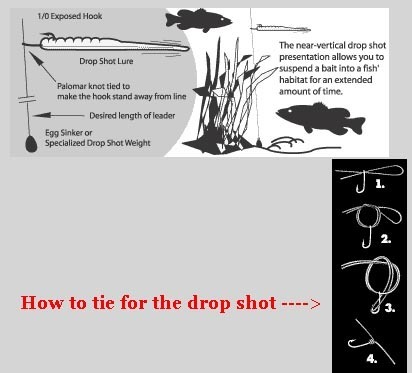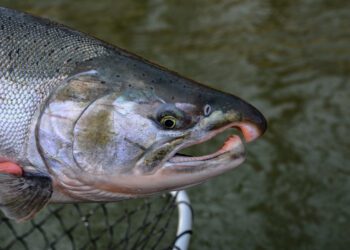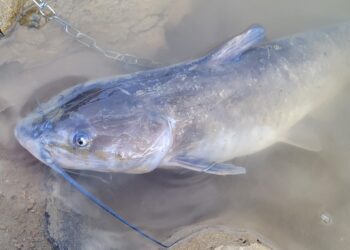
I am no expert by any stretch of the imagination, but I have grown fond of the Drop Shot technique in my short, four-season fishing journey. I have been using it for just over a season’s time. This is a very productive method to catch fish in a variety of states. In my first outing for smallies this season, I hooked and caught 3 smallies on three consecutive casts. It is the only method that has done this for me to date, and from the shore to boot. At the very least, I can share with you what I have learned through trial, error, and experience (which isn’t much).
You don’t need a Drop Shot specific rod. A medium-light to medium-action rod from 6’6″ on up to 7′ should work for you for now. If you find drop shotting to your liking, you can then opt to go with a Drop Shot specific rod of your choice. As a rule of thumb, a longer rod will enable you to have more line control and leverage; two big pluses in drop shotting.
I prefer spinning reels (a size 20 or 2500 reel is an excellent choice) because they require less work to give the bait a better (IMHO) descent than a baitcast reel. Sorry baitcast reel users, but the way a spinning drops the bait smokes a baitcast reel any and every day for drop shotting. To those who use baitcast reels exclusively, please note I said for drop shotting. There will not be a need to strip line off just to make the bait fall. With that said, casting reels can also be used. I just prefer a spinning reel. You may use whatever reel you want. Even a Barbie pole can get it done for drop shotting! However, I would opt for heavier line and a BC reel if I were to drop shot heavy cover.
Drop Shot Weight and Type
A 3/16 – 1/4 oz weight is a good starting weight. Going any lighter might make it harder for you to read what is going on until you get experience. As for the shape, I like to use either a teardrop or a cylindrical shape. I have not experimented with other shapes. Windier conditions and stronger currents might make you want to choose a heavier weight, but let’s not worry about that for now.
Line
Because you are drop shotting, lighter line is preferred if the cover you are fishing allows it. Go up in # strength if the cover dictates this. I like and use 6# fluorocarbon, particularly Seaguar’s Invizx. This line kicks fanny. No doubt about it. The plus in going with fluorocarbon in a higher # test if needed is despite having a slightly thicker line diameter; the angler retains the benefit of fluorocarbon’s trait of near invisibility as advertisers so claim. Whichever line you choose, I think the fluorocarbon line of your choice will be fine.
Baits
Keep an open mind here. Many baits of a variety of shapes can be used. The general rule of thumb is a tendency to use smaller baits since we are “finesse” fishing (translates to downsizing in general). The typical length of a drop shot bait usually ranges from 3″ – 4.5″ but this is NOT set in stone. Roboworm, Senkos, Sniper Snubs and Bolts (these two are locally made baits), Reaction Innovations Flirts, and heck, even Baby Brush Hogs and Tubes can be used. Think out of the box. I have used longer worms too. This season, the 4.5” Roboworm (in Aaron’s Magic) and Sniper Snubs in Watermelon and Dark Brown have been so effective that to date I have not seen a need to try something else or other colors. It might be different for bass in other waters. If you wish to know, so far the most effective baits for me have been, the snubs and roboworms.
Hooks/Knot
I prefer to use size 1 or 2 (mostly size 2) Gamakatsu Split Shot/Drop Shot hooks, or Owner Mosquito hooks. I attach the hook to the line with a Palomar knot and after it is tied, I insert the extra line (tag end) through the hook’s eye before attaching the weight. I have heard good things about size 4 Gamakatsu hooks, but I have not yet had a chance to try them yet.
Leader Length (Distance from the hook to the weight)
The best way to figure this out is to experiment. I have had success with leaders being as short 4-6″ to nearly but not quite 2′. Because drop shotting is not limited to a purely vertical presentation, a longer leader is a good idea if you wish to work it somewhat like a Texas or Carolina rig. The longer leader length (which I define here as the distance between the weight and your hook, perhaps 18″ as a ballpark figure) will enable you to keep the bait off the ground with the shallow angle that will result from a long cast. For a more vertical presentation, a shorter distance from the hook to the bait can work.
Imparting Life to the Lure
Despite the initial perception of working this lure, it is not all about jiggling and wiggling the bait. An angler can indeed work the bait this way, but I can tell you from personal experience, that wiggling and jiggling has accounted for the fewest number of catches.
So what should one do in addition to the wiggling/jiggling tactic?
Keep the weight on the bottom for the most part and leave enough slack to let the bait sink on its own weight. Then, when you think the bait is near the bottom lift/twitch the rod just enough to move the bait a little (without moving or minimizing the movement of the weight on the bottom) and repeat. In effect, what you are doing is working a semi-slack line and this is what is imparting action to the bait. No hits? Repeat if you wish, or add a little dead sticking to the mix or, drag your bait to the next spot. All are good choices. The dragging of the weight from one spot to the next also imparts life and action to the lure and can help to draw a strike. In addition, working with the slack and dead sticking have been far more effective for me compared to wiggling and jiggling the bait to death
Not sure what the bait will do? Find some shallow water and drop down your bait. The depth should be one where you can see all the way to the bottom. Once the weight is on the bottom, let your bait fall by lowering your rod. Before the lure hits the bottom, raise the rod’s tip enough to bring the lure up, and do your best to keep the weight in place. Watching this will give you an idea of what will likely be happening when you are not able to see the bait with your own eyes. Visualizing what the bait is doing when I can’t see it helps me to focus on what I am trying to do, and that is catching fish.
The Strike or Hit
This can vary depending on the activity level of the fish, the quality of your set up to a certain extent, and the line you are using. More sensitive rods do a better job of transmitting what is going on to you. I have had the blessing of drop shotting with my Berkley Cherrywood Rod, which is decent and not too shabby, but comparing it to my Lamiglas Certified Pro Drop Shot rod is something else. Here is my analogy. If the Cherrywood provides stereo sound to me while watching a DVD movie, the Lamiglas gives me the sound in THX, for the full cinema experience. The latter rod is not necessary to enjoy drop shotting, but it makes it a lot easier to feel and detect the subtle strikes.
The line you use also can influence the feel of the strike. My experience working with both mono and fluorocarbon is that the latter always seemed to give me a better picture. We all know now that although FC line can have as much or more stretch than a comparable monofilament line, it is likely that its density still enables it to beautifully transmit information from the end of our line, to the rod and to our hands.
The hit or strike can feel like:
1) A mushy tug or tick, which could translate to a complete inhalation of your bait or the fish attacking the lure from the hook’s side.
2) A nibble or nibbling, that transmits vibrations through the line to you. Sometimes you can see or feel the line vibrate through your semi-slack line. More sensitive rods tell you this much better and more clearly. I believe when the hit is like this (my best guess anyway as I visualize the strike), it is possible that the fish might have taken the lure from the side opposite the hook and the nibbling/vibrations you feel is the fish taking in the bait into its mouth, eventually getting to the hook.
3) Bam! It’s on!
The Hook Set
For one and three, just reeling up the slack and adding enough tension to make the line taught is sufficient for most cases to drive the light wire hook home. For case two, you have to wait until the fish gets to the hook and then do as mentioned above. If you don’t, you will pull the lure from the fish’s mouth. Since it didn’t get to the hook, there is no way the fish can get hooked.
I have written this based on the experience I gained from drop shotting. Take it for what it’s worth, an opinion at best. I will close by giving you a final warning:
WARNING: Drop Shotting is as addictive as it is effective.
Good luck and go get’em!























